



Argiope bruennichi, Wasp spider
Cocoon weaving and eggs laying
Abstract Variation Cocoon and eggs More information Young spiders Males spiders Postscript

Argiope bruennichi with wind blown seeds in the web
Abstract:
Phylum: Arthropoda
Class: Arachnida
Order: Araneae
Family: Araneidae
Genus: Argiope
In my garden I found in two consecutive years, 2008 and 2009, a specimen of the Wasps spider, (Argiope bruennichi), that is found in The Netherlands since 1980. After the harsh winter (2009/2010) I did not expect to have this spider in the garden again. But on 24-07-2010 I do again discover a Wasp spider in the garden. The large web is covered with wind blown seeds so you can see it very clearly.
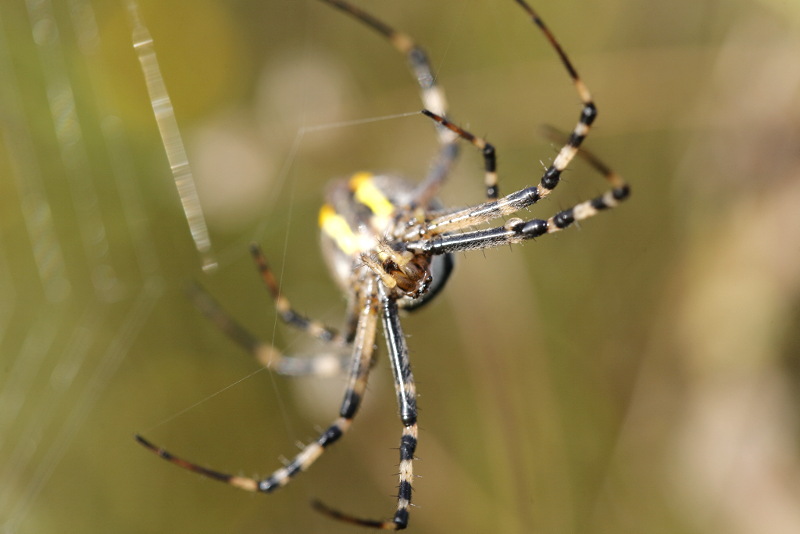
Argiope bruennichi, building a web
Variation:
2010 seems to be a year with a complete invasion of these spiders, one day I counted 23 in the garden. They build their webs close to the ground between the grass. This web is at an angle of 60 degrees with the bottom and the spider hangs upside down at the bottom of the web. A desperation to get a picture of it. Most spiders sit between dense grass and since there are many European hornets flying around, I don't dare to remove the grass around the spiders, to be able to make a picture, because they than will be, an easy prey for the wasps. Only from some I can make a picture of the top side. The photos that I have, show that the drawing of the spiders is quite variable.
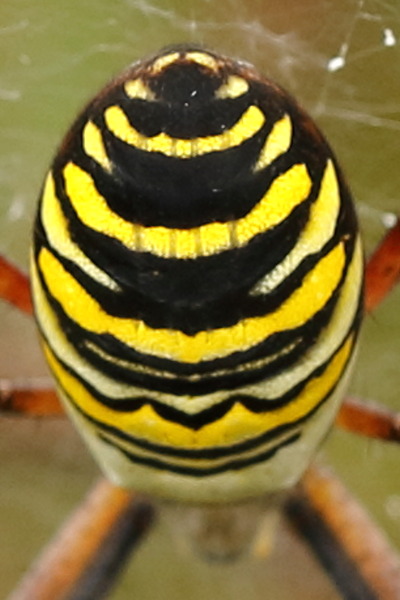
Argiope bruennichi

Argiope bruennichi

Argiope bruennichi
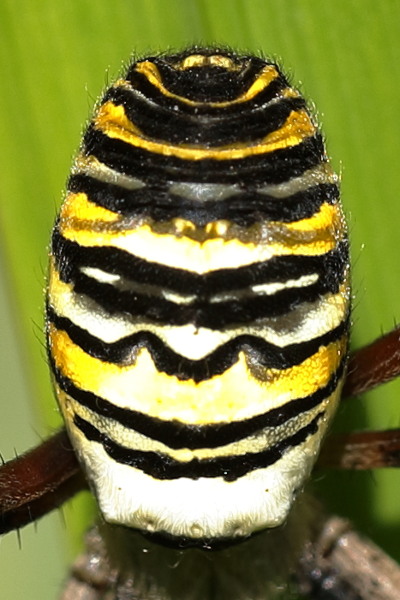
Argiope bruennichi

Argiope bruennichi
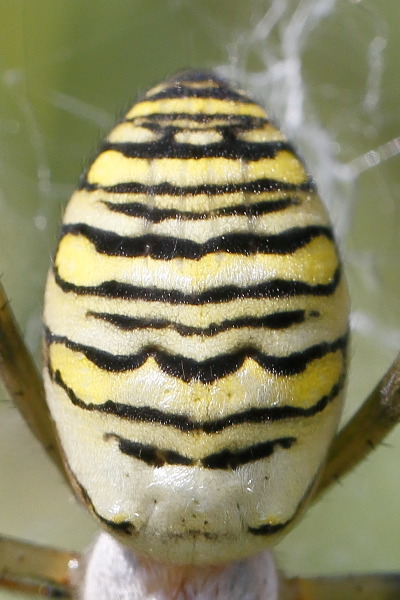
Argiope bruennichi

Argiope bruennichi
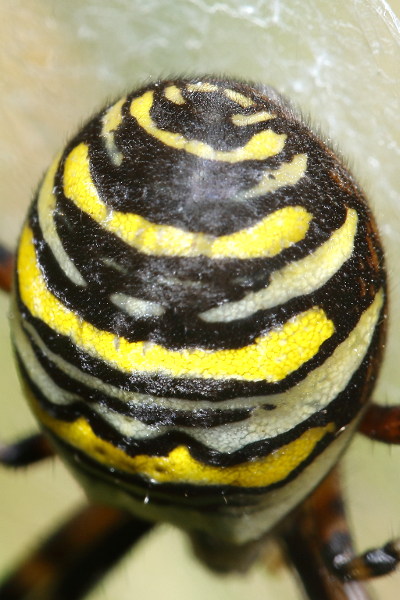
Argiope bruennichi

Argiope bruennichi
Cocoon weaving and eggs laying
The spiders lay their eggs in a kind of pot. It was pretty difficult to find them. I was expecting to find them next to the web, but sometimes there is fifty centimetres between web and cocoon. The cocoons are on about fifteen to fifty centimetres above the ground and being attached to the plants. Without you loosen them they are hard to photograph, therefore three different side by side to form an impression. The cocoons have a diameter of about two to three centimetres and have dark stripes.
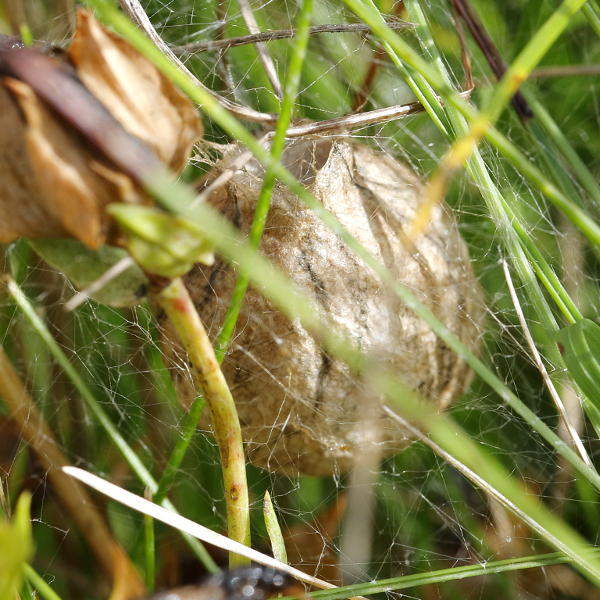
Argiope bruennichi, cocoon
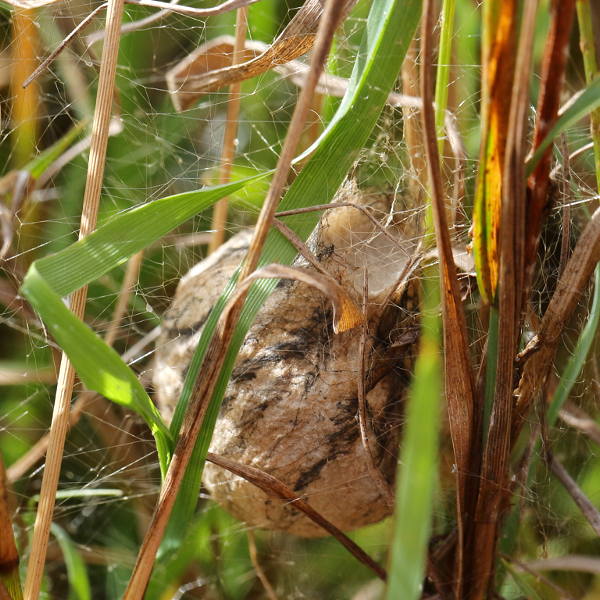
Argiope bruennichi, cocoon
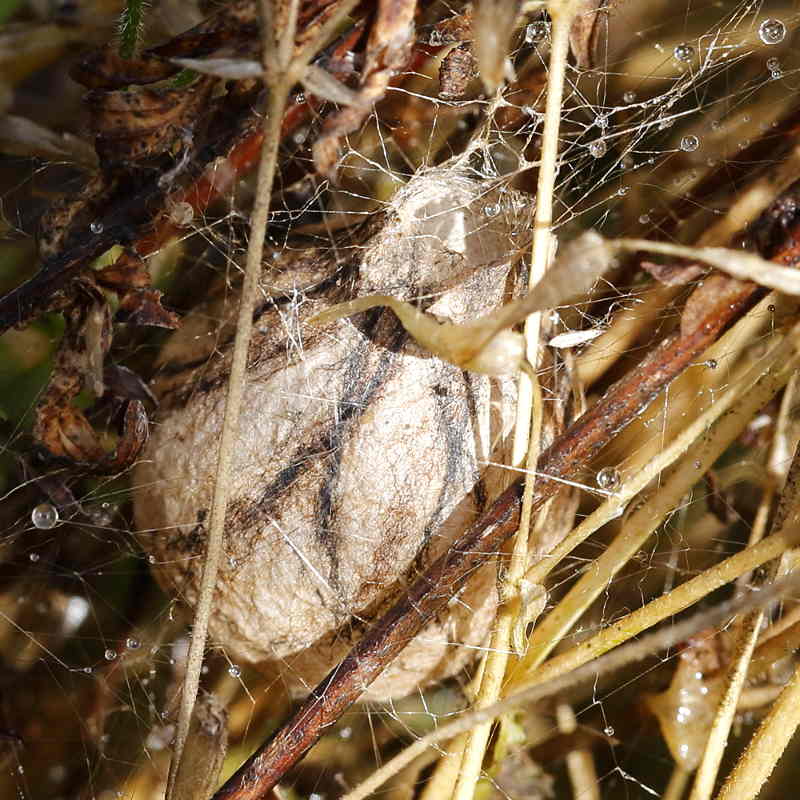
Argiope bruennichi, cocoon
9-9-2010 A long time already I wondered how the Wasp spider gets her eggs in the cocoon. The cocoons are,
if you look at them, just small bottles with cork. My assumption was, first make the bottle,
lay eggs in it and shut down at the top.
But it doesn't work like that.
The spider starts with the lid of a densely woven light-colored silk, that under a free open threads tangle is woven.
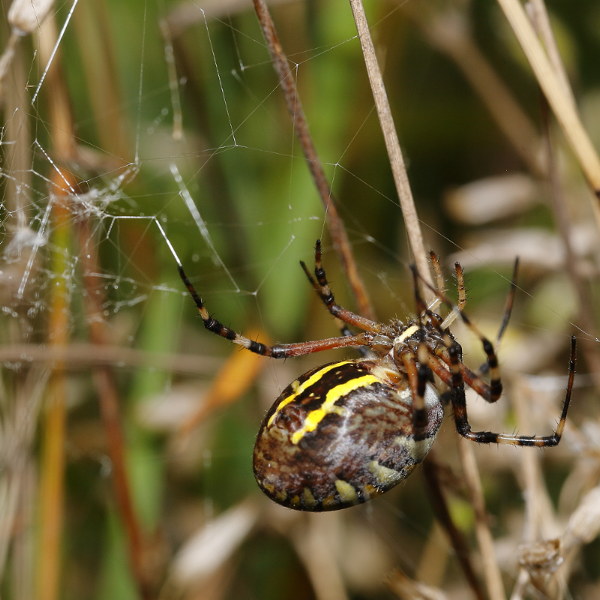
Argiope bruennichi weaving the lid

Argiope bruennichi weaving the lid
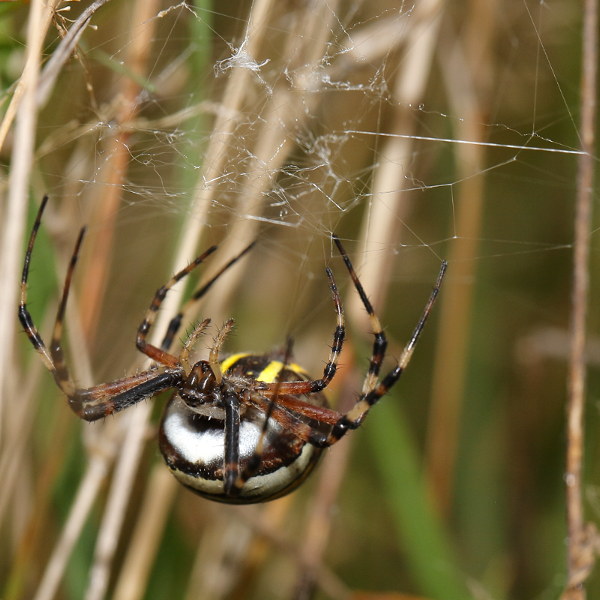
Argiope bruennichi weaving the lid
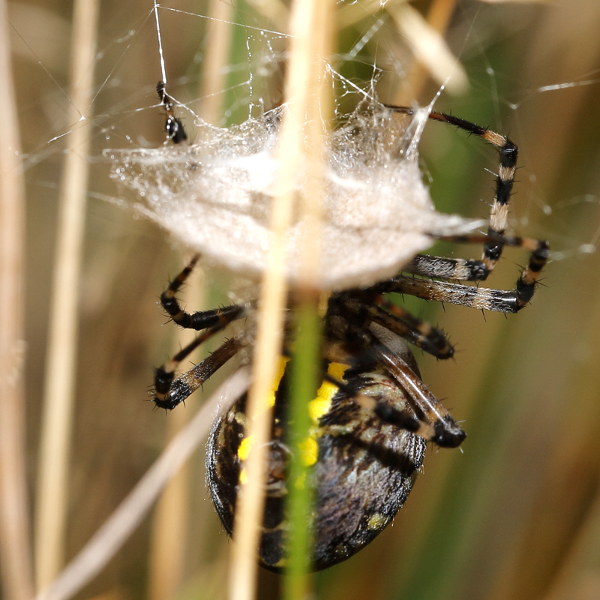
Argiope bruennichi weaving the lid
There under a kind of plug is made from very open loose woven silk. The bottom of the plug is covered with a mat of densely woven lighter colored silk that is glued to the bottom edge of the plug. If this is done, the spider still makes a few rounds and put fixed the mat further to above.

Argiope bruennichi plug weaving
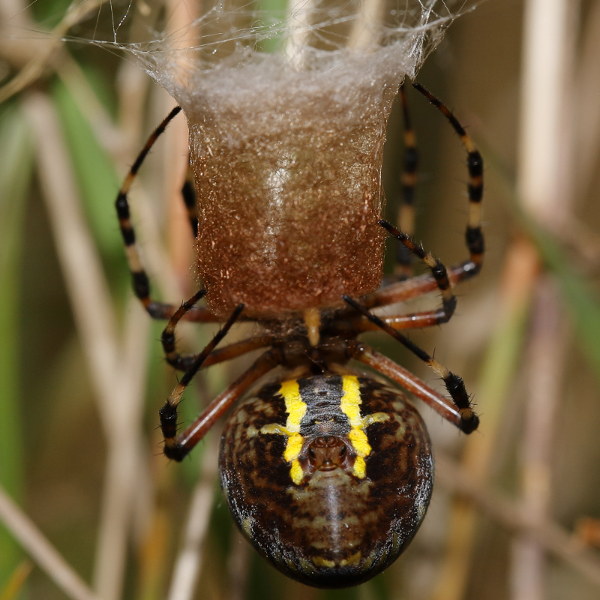
Argiope bruennichi plug weaving
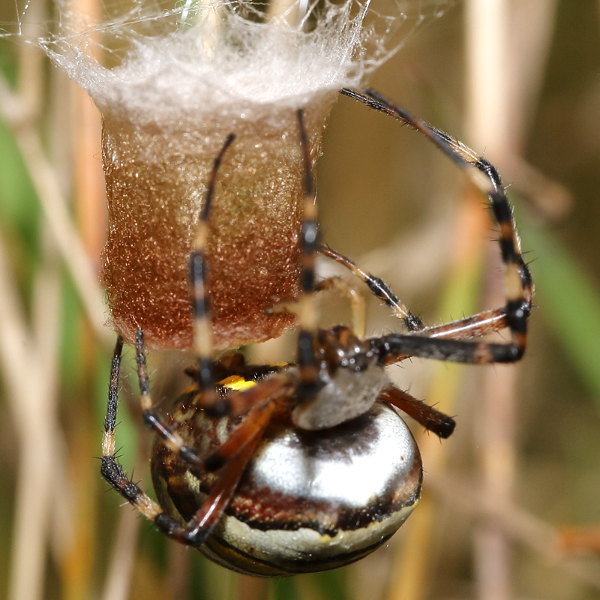
Argiope bruennichi mat weaving
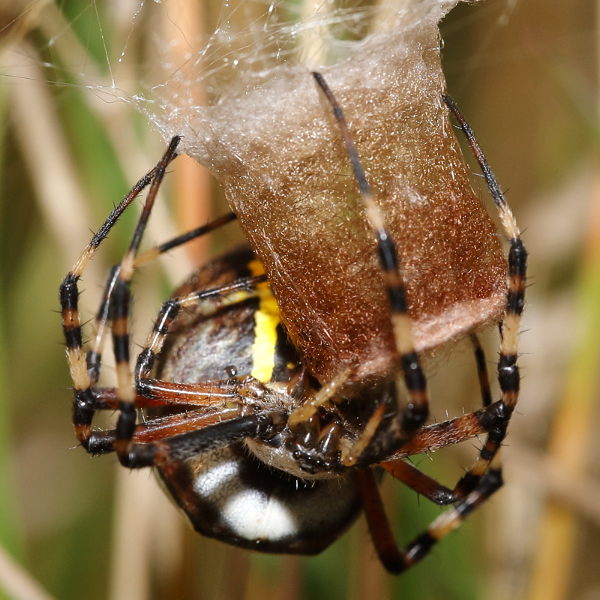
Argiope bruennichi fix the mat
Now the spider with the belly up hangs under the mat and starts to lay eggs. You see appear a yellow drop eggs on the belly of the spider. As the droplet eggs grows larger, the spider pushes her entire body against the mat. The droplet of eggs paste than stuck to the mat. The eggs laying continues and the eggs mass is regulary pushed against the mat. Eventually there is a hefty lump of eggs at the bottom of the mat.
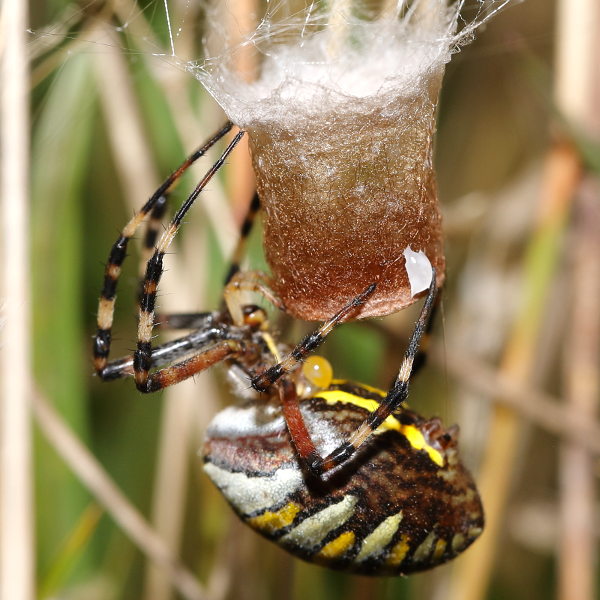
A. bruennichi eggs laying
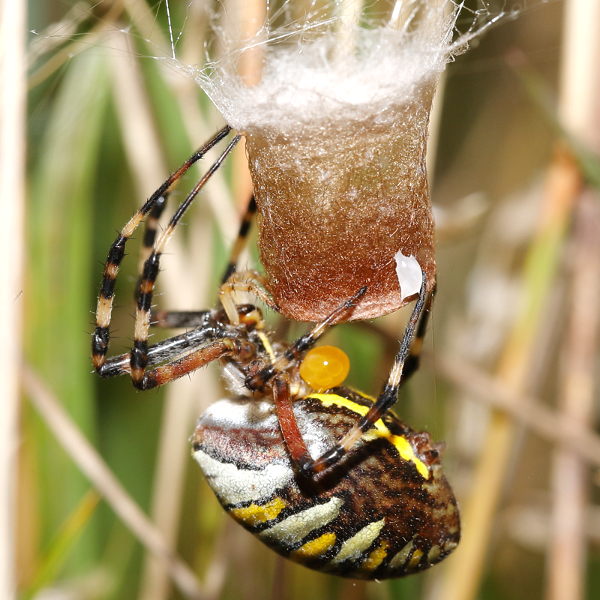
A. bruennichi eggs laying
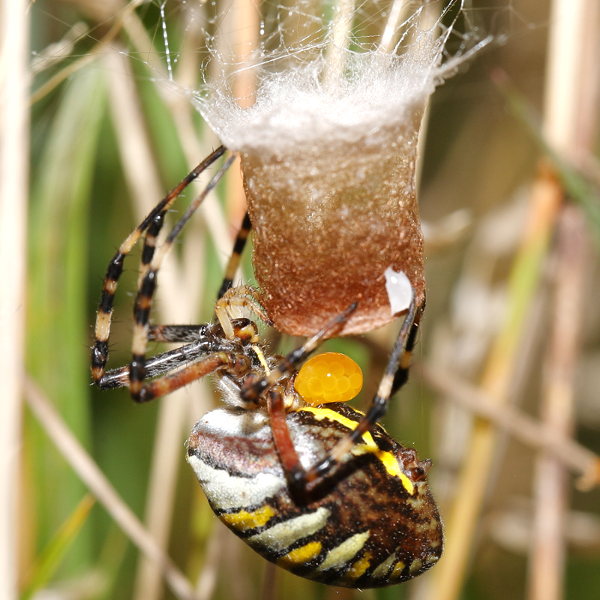
A. bruennichi eggs laying
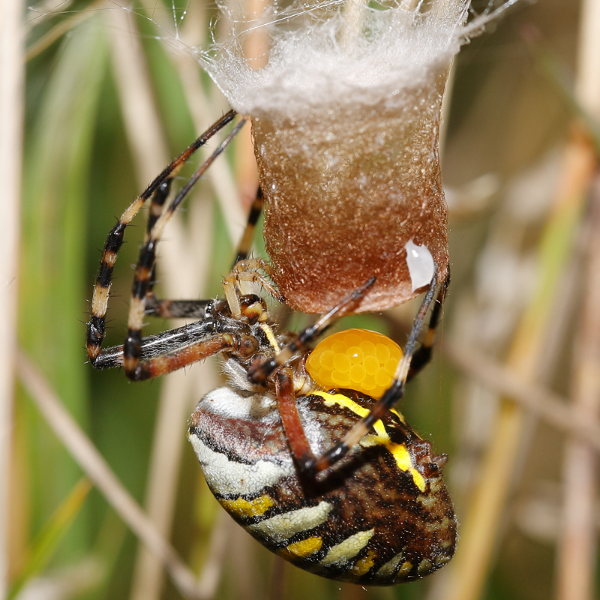
A. bruennichi eggs laying
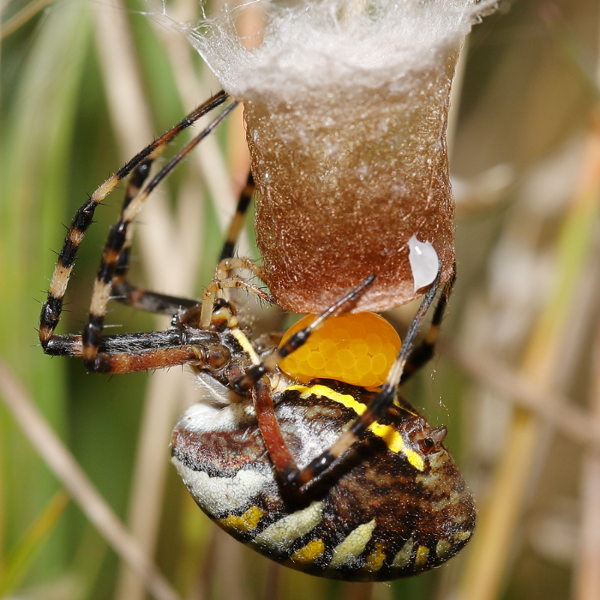
A. bruennichi eggs laying
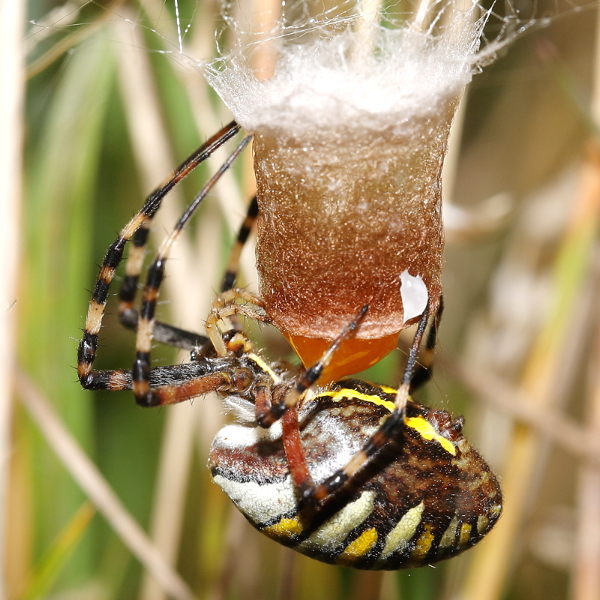
A. bruennichi eggs laying

A. bruennichi eggs laying
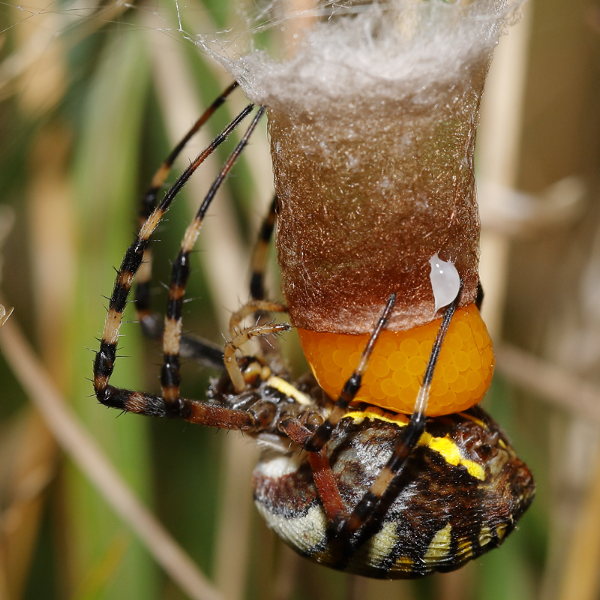
A. bruennichi eggs laying

A. bruennichi eggs laying
As the spider has finished the laying, it weaves a layer of white silk around the eggs, It seems the same silk she also uses to pack her prey, only the packing goes much quieter. This spinning with white silk unnoticed turns into the loose brown wires that also are used in the plug.

Argiope bruennichi weaving white silk
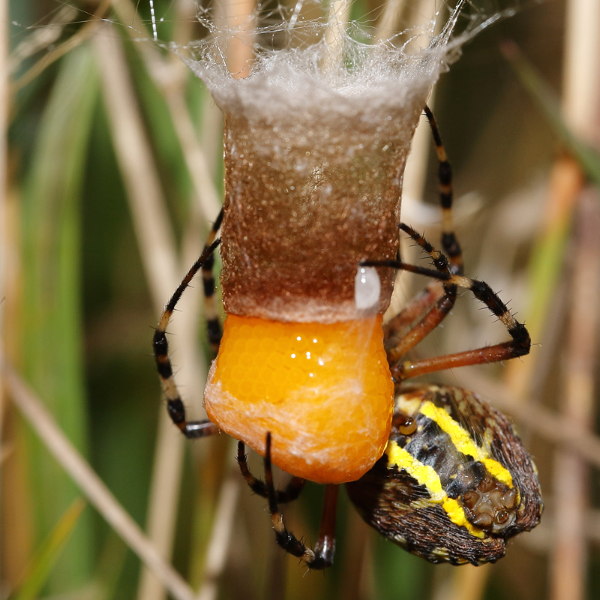
Argiope bruennichi weaving white silk
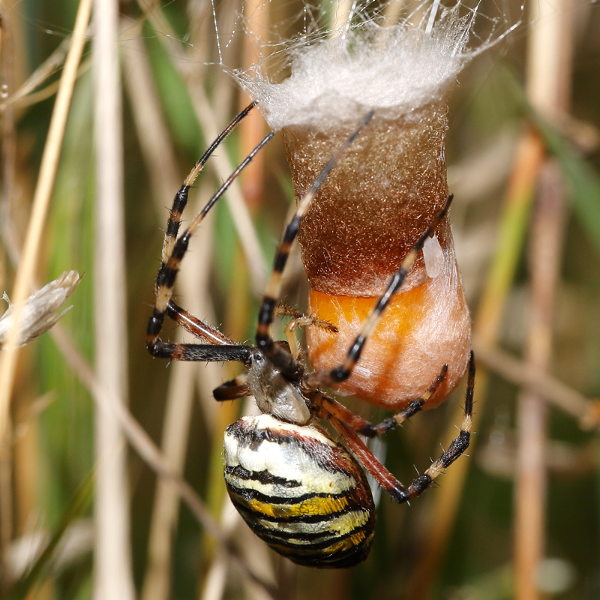
Argiope bruennichi weaving white silk
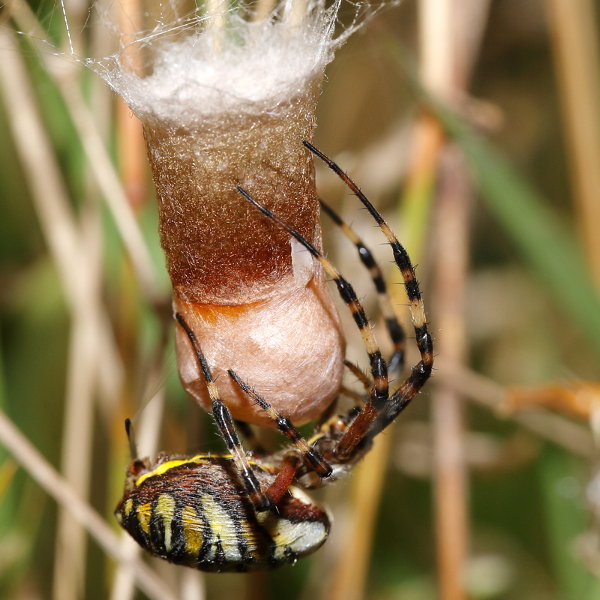
Argiope bruennichi weaving white silk
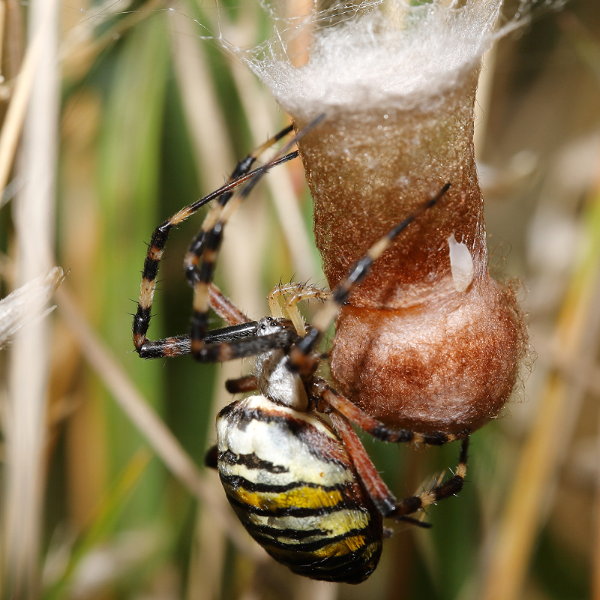
Argiope bruennichi weaving brown silk
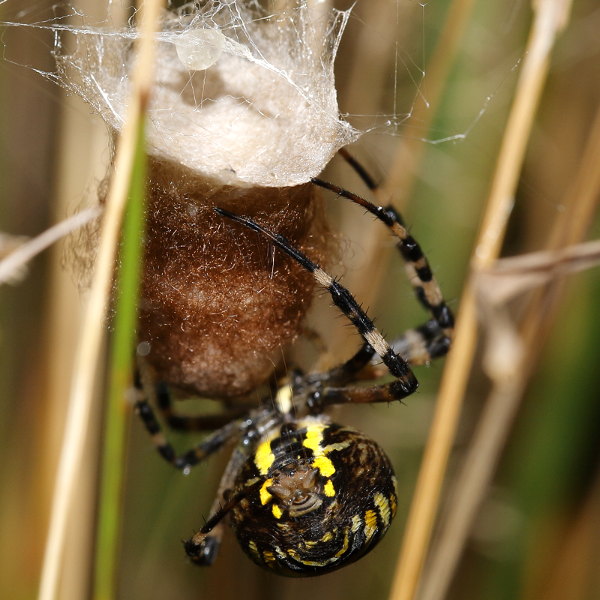
Argiope bruennichi weaving brown silk
Later this becomes again a loose tissue of white silk and the outside is made with the pattern of black stripes.
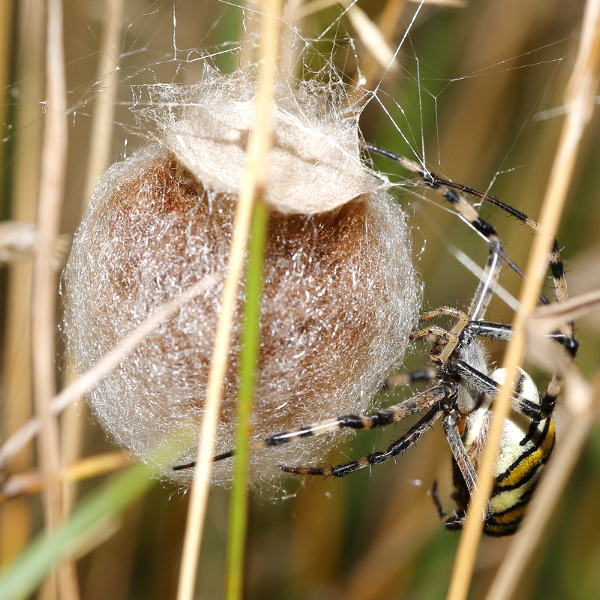
Argiope bruennichi loose silk
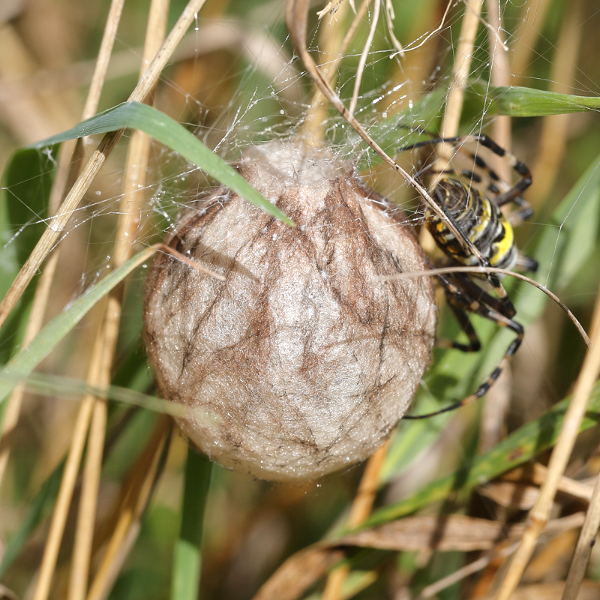
Argiope bruennichi outside cocoon
The whole is then very firmly anchored in the grass with thick wires that are further apart.
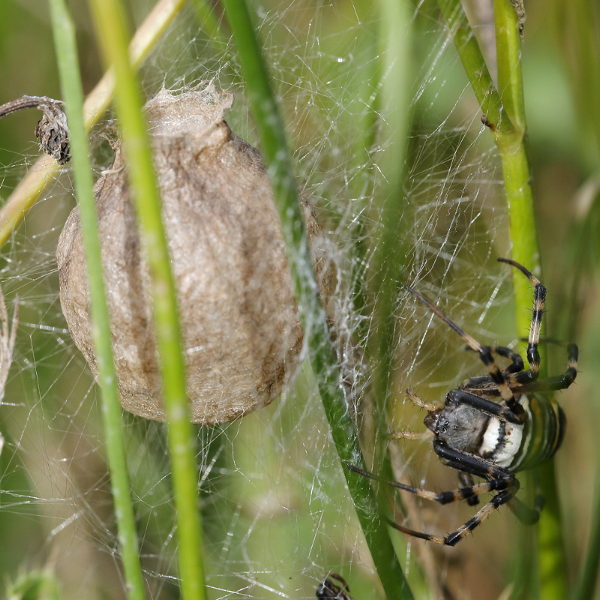
Argiope bruennichi anchoring cocoon

Argiope bruennichi anchored cocoon
The whole process takes several hours and at the two spiders that I have observed they started at dusk and it takes
until late at night before everything is ready.
Of the first spider I haven't seen when it starts, I discover all of a sudden the lid. After I've made some pictures,
I have waited half an hour and than I am once again going to look.
It's cold and rainy with a lot of wind. I'm too late to see the laying of the eggs, the spider is already working
to weave in the eggs.
Another hour later she created the loose tissue to the eggs.
It is than eleven o'clock in the evening.
The completed cocoon I photographed the next evening, the spider is still sitting on the cocoon.
As I am working on I see that the spider sitting right next to it has not spun a new web, but laps run under a loose tissue.
It is clearly also weaving a lid. Through the experience of the day before,
I'm going to watch it again within half an hour, and then stay over an hour at the spider to capture the egg deposition.
Some spiders do have made three cocoons, at others I can't find anything around the web.
The distance from cocoon to the nearest web ranged from single decimeters to almost a meter.
More information:
Of the many wasps spiders that I found this summer in the garden, there are mid-september but little about it.
It seems that the cold weather makes that the spiders are less active. Every
now and then a spider remains sitting days at the freshly laid Cocoon.
On one of the cocoons has a crab spider found a new hunting ground.
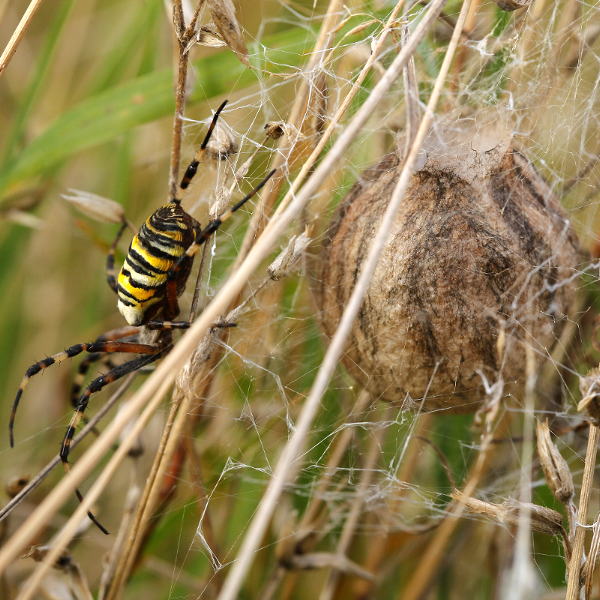
Argiope bruennichi days at the new cocoon
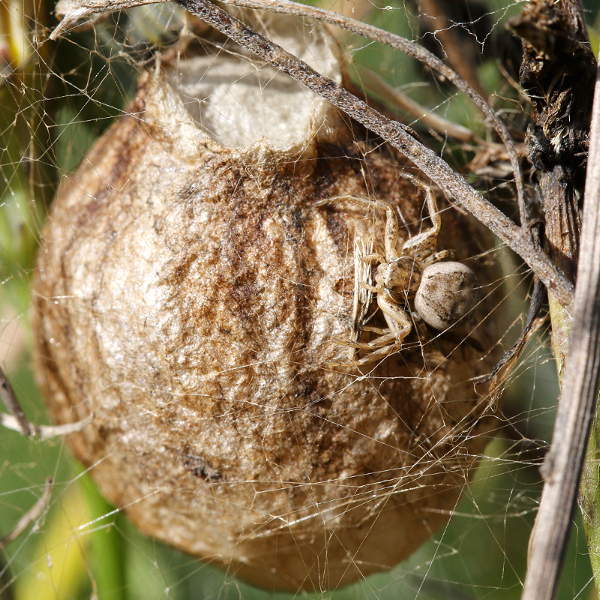
Argiope bruennichi cocoon with krab spider
Males of the Wasps spider I haven't found. On a picture of a female is an out of focus smaller spider that could be a male, but I saw it only when I looked at the picture on the computer and I could not find it back in the garden. So there is still something to look forward to next year. Finally, two pictures of a spin with the most common prey, the grasshopper.
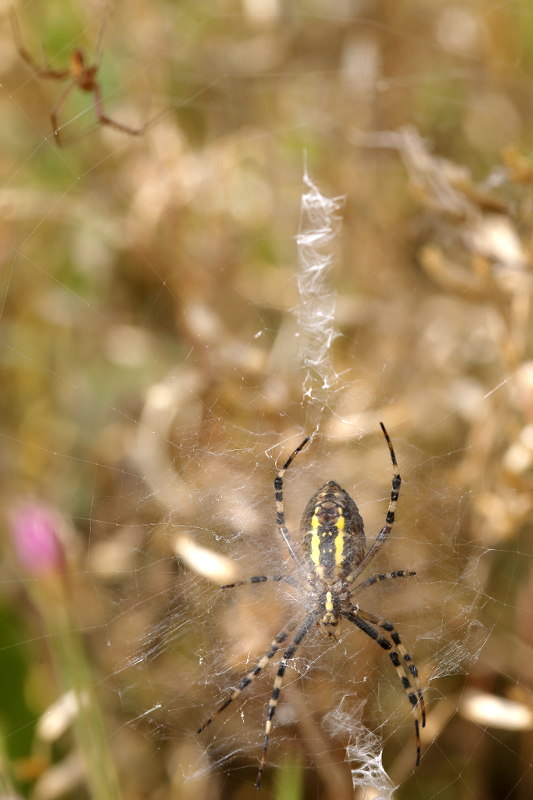
Argiope bruennichi
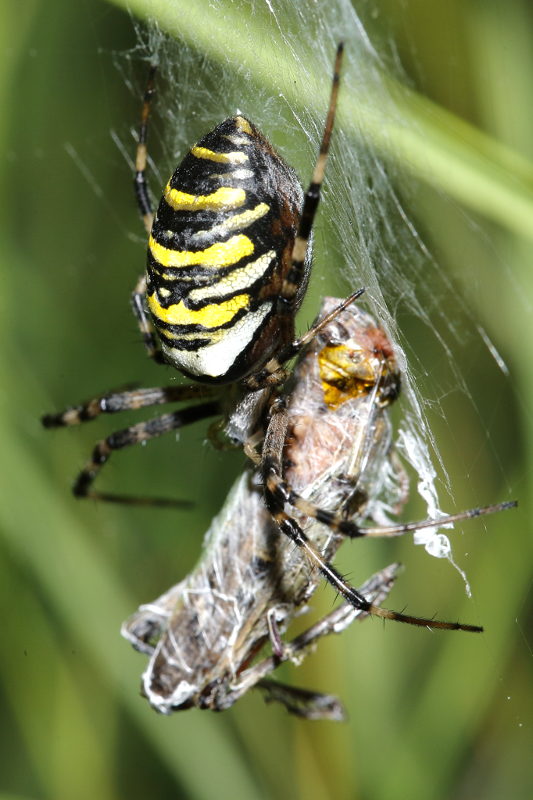
Argiope bruennichi, grasshopper prey
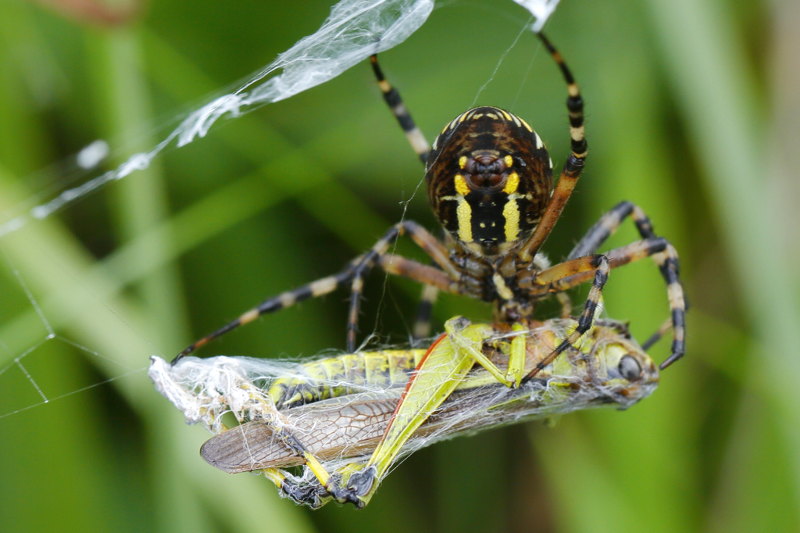
Argiope bruennichi with prey Stethophyma grossum
27-11-2010 It freezes and the cocoons look not all good. Some are what shriveled. I'm wondering wether there come next year many young spiders.

in the freezing cold

in the freezing cold
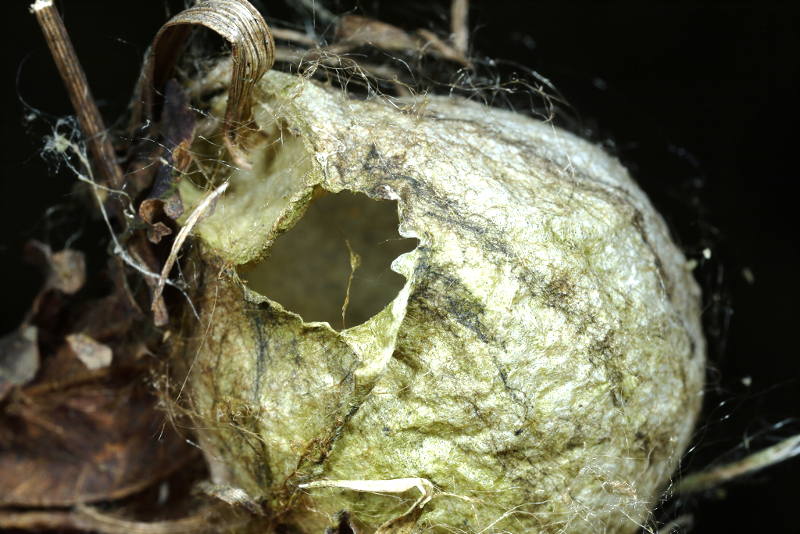
Argiope bruennichi empty cocoon
24-03-2011 Some cocoons are empty, there is a hole under the lid and the cocoon is completely empty, there are no silk thread, eggs or young animals anymore. In an empty cocoon I find an old skin and shed head of I think a caterpillar, but before I can watch well the wind is blowing it away. So it seems that there is an insect larva that eats the content of the cocoons.
Young spiders:
10-04-2011 There is a cocoon where the brown silk of the plug is sticking out and because I think this Cocoon is also eaten I pull to the brown silk and see that there are young spiderlings in it. After I've made some pictures I put the cocoon back between the grass. On the pictures you can see the young spiderlings and the shed skins of a previous molt of the little spiders.
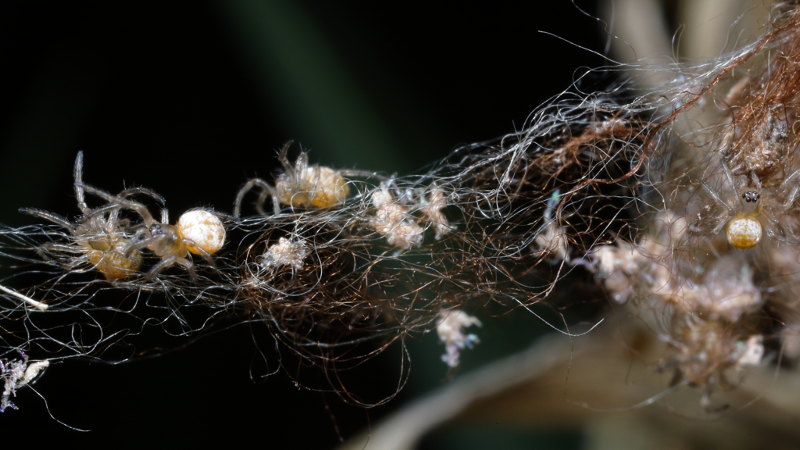
Argiope bruennichi young spiders

Argiope bruennichi young spiders

Argiope bruennichi young spiders
26-06-2011 It worked, today I found the first young spiders in their web. They are still very small but the web has allready the zigzag drawing. With the necessary effort I managed to get two on the picture, one from above and one from the bottom side. They sat close to each other and it gives hope on a large quantity of wasp spiders in the garden this year.
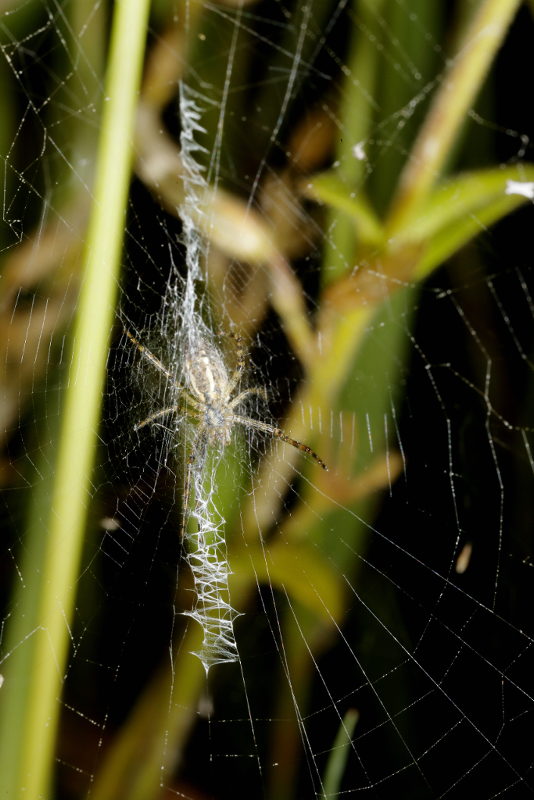
Argiope bruennichi young spider in web
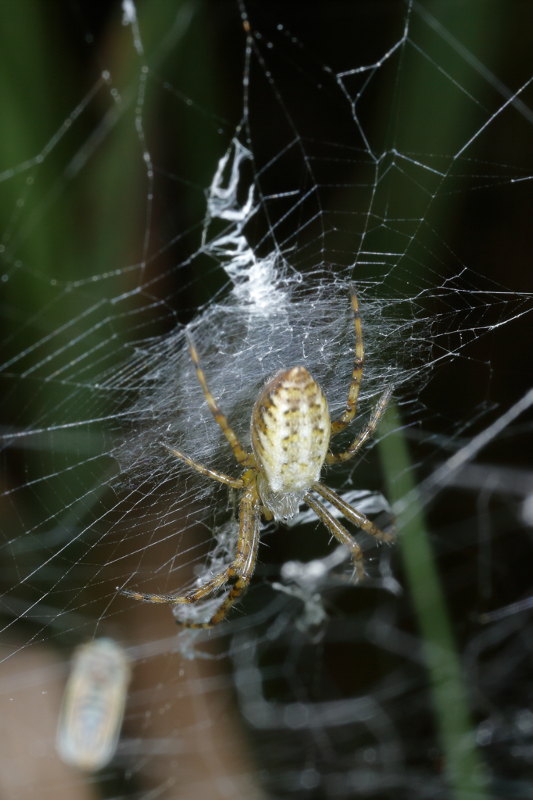
Argiope bruennichi young spider in web
Males spiders:
Adult males spiders you can recognize to the bulges on the pedipalps. Popular also called boxing glove.
It is an easy-to-see attribute.
22-07-2011. In the nature reserve the Metbroekbosch in Smeerling I have found some spiders. It was an adult female, two adult males
and fourteen young females. So finally pictures of the male.
The left one clearly demonstrates the boxing gloves, the right one is what battered, it lacks a boxing glove and a leg.
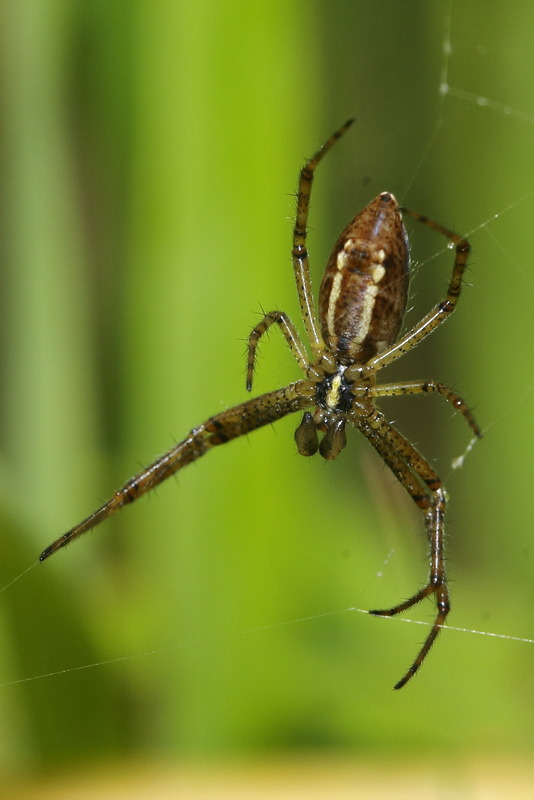
Argiope bruennichi male
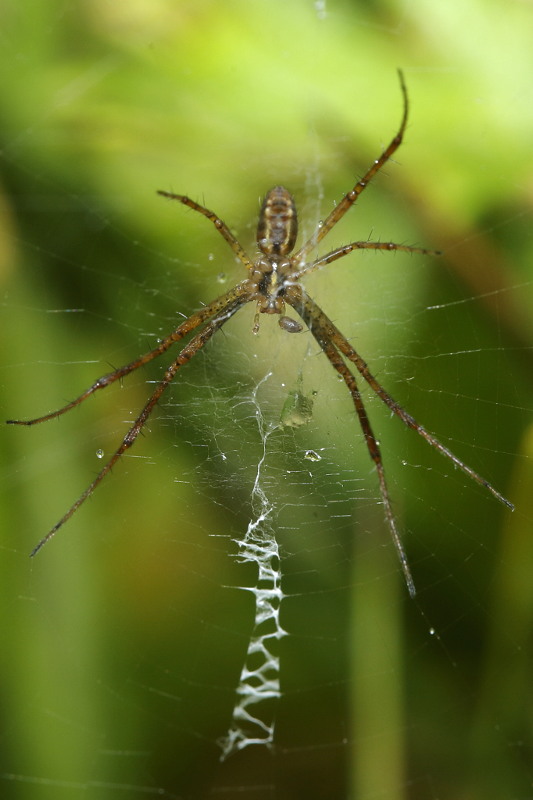
Argiope bruennichi male
A male has built his web just about five cm away from the web of a young female, you see them together on the big picture below.
Below the male from the dorsal side and the same male, where the boxing gloves are visible very clear.
To this boxing gloves, the thickened palps, you can recognize male spiders. They are used in mating.
The male makes a small web, put a drop of sperm on and takes it on in the palp that works like a sort of fountain pen.
At the mating the male spider brings in his sperm in the female using this palp.
The form of the palp only fits in females of the same species, the so-called key and lock principle.
It is different with each species, just as the epigyne, the female external sex organ.
Both are often used to determine the species.
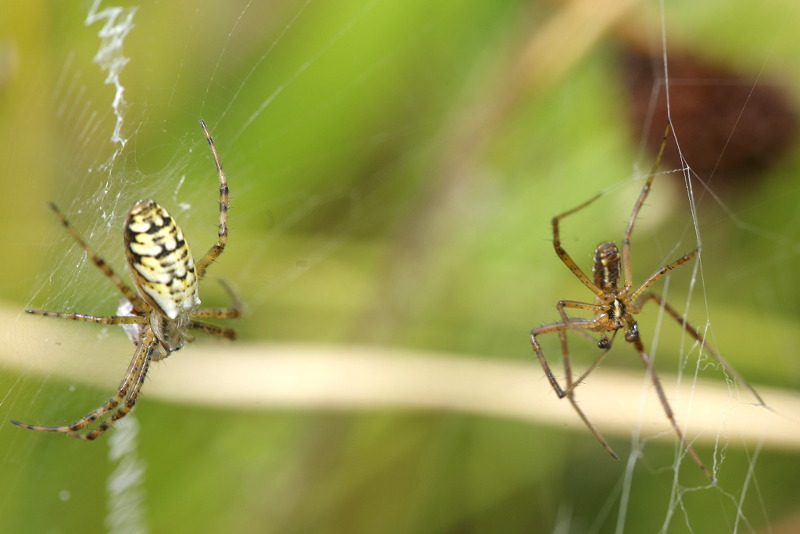
Argiope bruennichi couple
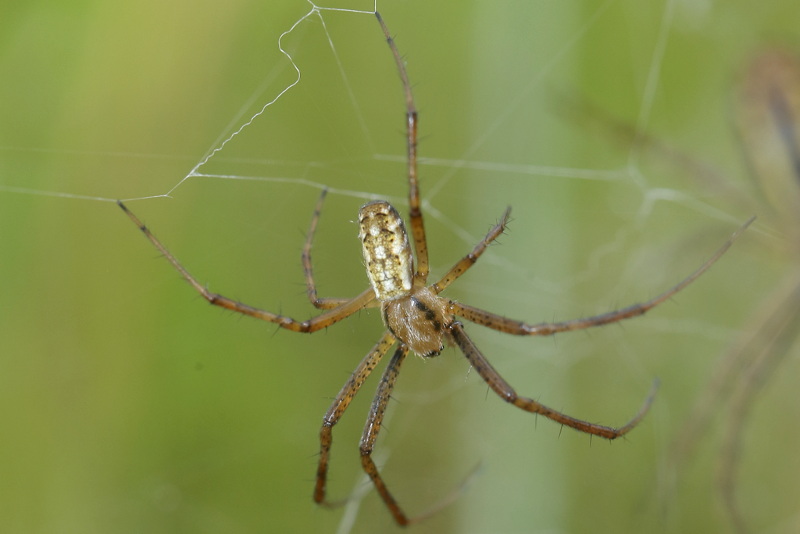
Argiope bruennichi male
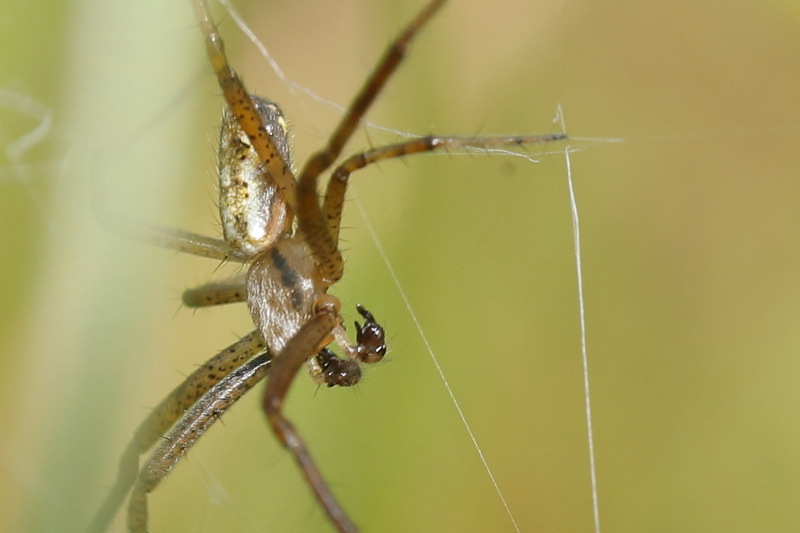
Argiope bruennichi male

Argiope bruennichi male

Argiope bruennichi male
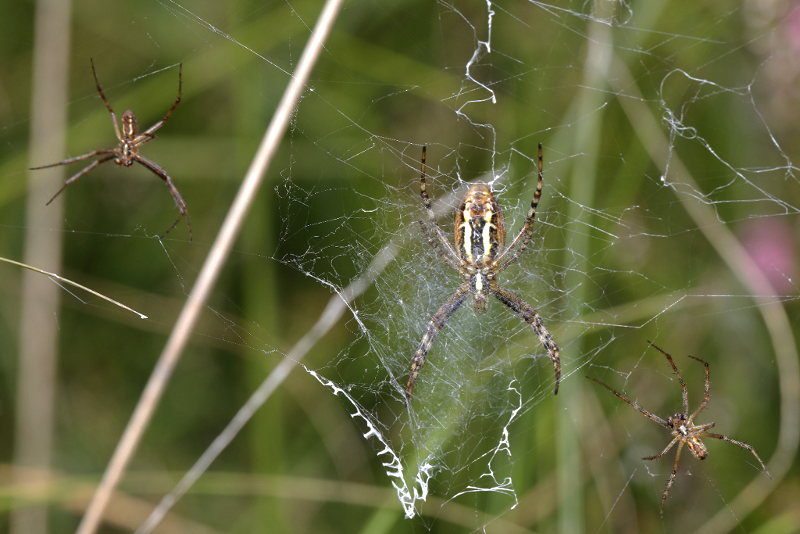
Argiope bruennichi female with two males
Postscript
17-08-2011.
Finally, Martha has found an adult female wasps spider in the garden.
11-09-2011. It's been a bad summer for the spiders in the garden. Total I have seen three
adult spiders and found two cocoons.
On my visits to natural areas I find this year the normal batch. It may be that last year was an
exception in our garden, with large numbers of this species spiders.
2012 This year two females found in the garden and from one 2 the other 1 cocoon (s). This is apparently an ordinary number and 2010 was an exception with 23 spiders. At some visits to the nature reserve het Meerstalblok in Zwartemeer this year I really have seen very large numbers of wasp spiders and lots of egg cocoons.

Argiope bruennichi 2012
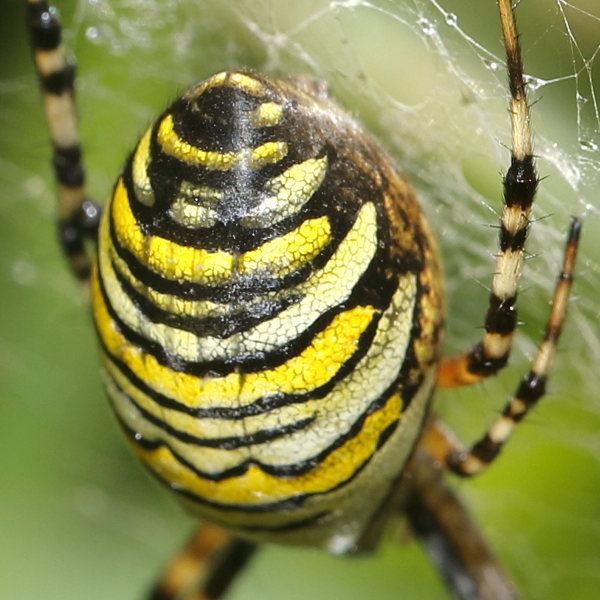
Argiope bruennichi 2012
29-07-2014 The previous year (2013) a small number of adult spiders in the garden. This year there are again very much. On a round 21 spiders seen in recent days, also some males, today no males. It is still too early for egg cocoons, many of the females are not yet mature. The strange thing is that this year the spiders are in the more cultivated part of the garden , in the more wild part where they were always sitting, I haven't found one.
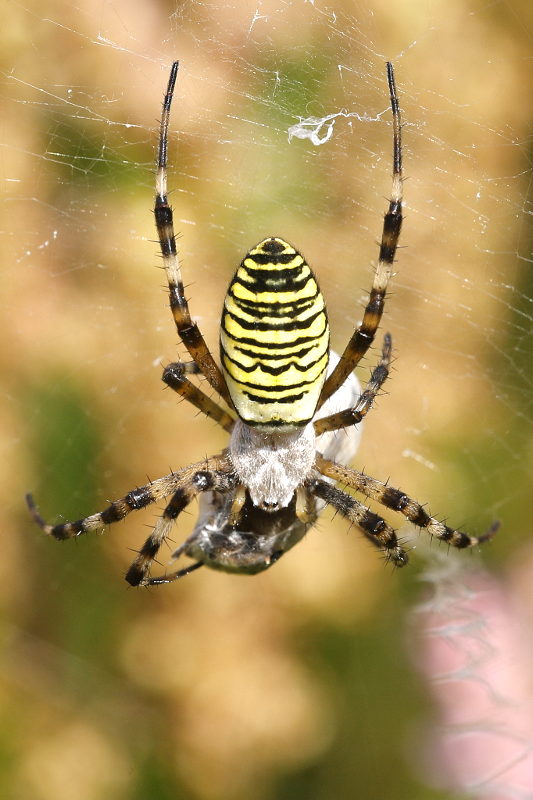
Argiope bruennichi 2014

Argiope bruennichi 2014
Today 13-08-2014 for the first time caught a European hornet that has eaten one of the spiders. The picture is not very clear to see what it eats, but it was in the web of a wasp spider and it looks that the spider is eaten with prey and all.

Vespa crabro, European hornet 13-08-2014
10-11-2014 The spiders were quickly disappeared this year, I think the biggest part is eaten. Cocoons I have seen little, but one and that was after two days already empty eaten, probably by the mice.
14-08-2015
Behind the female's web you can see the loose construction of the web made by a male.

Argiope bruennichi, loose thick threads
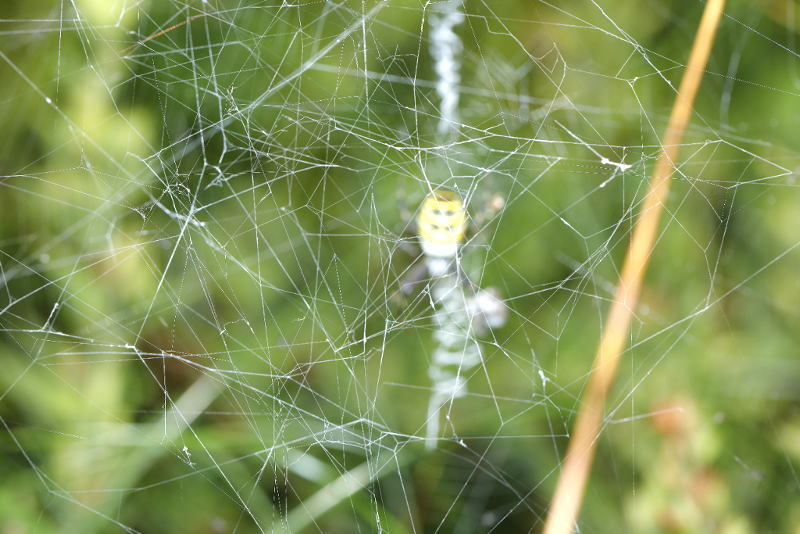
Argiope bruennichi, loose thick threads
19-09-2016
Despite all the trouble the spin does, to make a good protection for the eggs, there are always animals that manage to find the eggs.
Here is a female ichneumon wasp busy laying her own eggs in the eggs of the spider.
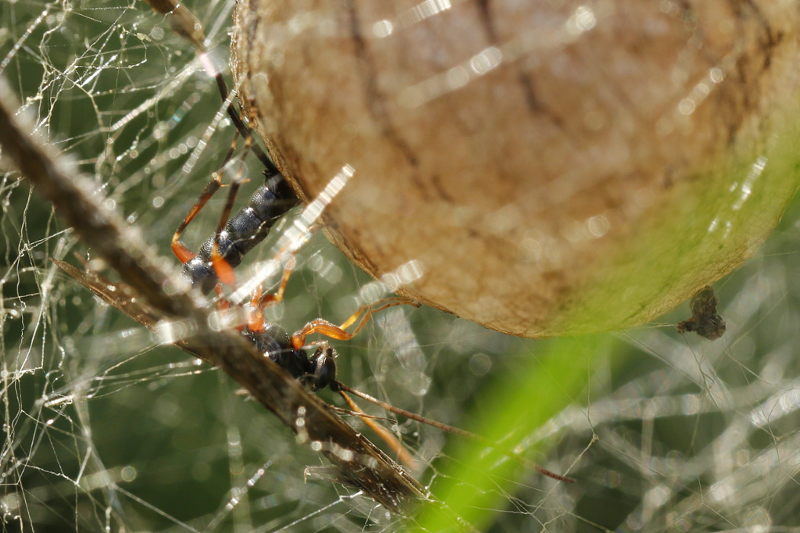
Ichneumon wasp ♀
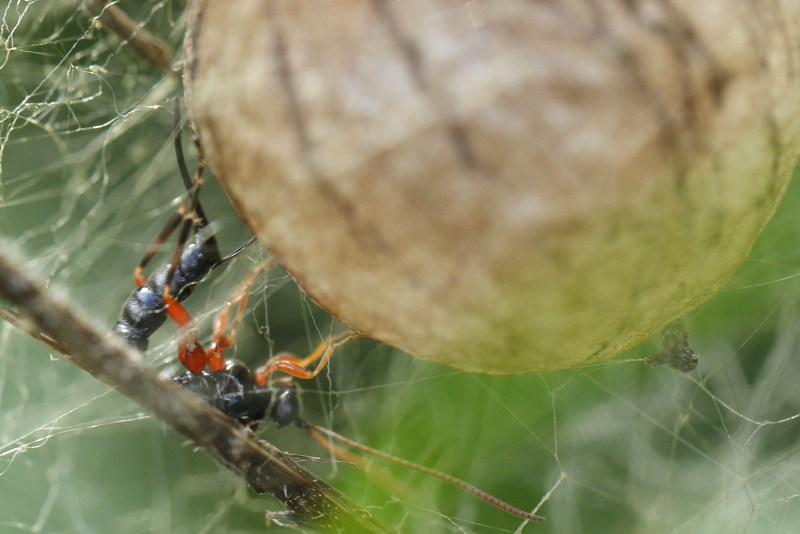
Ichneumon wasp ♀